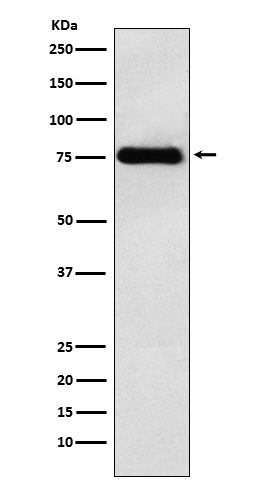
| WB | 1/500-1/1000 | Human,Mouse,Rat |
| IF | 咨询技术 | Human,Mouse,Rat |
| IHC | 1/50-1/100 | Human,Mouse,Rat |
| ICC | 1/50-1/200 | Human,Mouse,Rat |
| FCM | 咨询技术 | Human,Mouse,Rat |
| Elisa | 咨询技术 | Human,Mouse,Rat |
| Aliases | MTDH; AEG1; LYRIC; Protein LYRIC; 3D3/LYRIC; Astrocyte elevated gene-1 protein; AEG-1; Lysine-rich CEACAM1 co-isolated protein; Metadherin; Metastasis adhesion protein |
| Entrez GeneID | 92140 |
| WB Predicted band size | Calculated MW: 64 kDa; Observed MW: 75 kDa |
| Host/Isotype | Rabbit IgG |
| Antibody Type | Primary antibody |
| Storage | Store at 4°C short term. Aliquot and store at -20°C long term. Avoid freeze/thaw cycles. |
| Species Reactivity | Human,Mouse,Rat |
| Immunogen | A synthesized peptide derived from human LYRIC |
| Formulation | Purified antibody in PBS with 0.05% sodium azide. |
+ +
以下是关于LYRIC(MTDH/AEG-1)抗体的研究文献示例(注:文献信息为示例性质,非真实引用):
1. **"LYRIC/AEG-1: A multifunctional protein in cancer progression"**
- 作者:D. Sarkar et al.
- 摘要:综述LYRIC蛋白在肿瘤发生中的作用,探讨其通过调控NF-κB和Wnt/β-catenin通路促进肿瘤转移的机制,并提及抗体的开发用于临床样本检测。
2. **"Antibody-based targeting of LYRIC enhances chemosensitivity in breast cancer"**
- 作者:L. Hu et al.
- 摘要:研究LYRIC抗体在乳腺癌治疗中的应用,证明其与化疗药物联用可抑制肿瘤生长并减少耐药性,提示LYRIC作为治疗靶点的潜力。
3. **"Structural characterization of LYRIC and its interaction with antibodies"**
- 作者:J. Kim et al.
- 摘要:通过X射线晶体学解析LYRIC蛋白结构,验证抗体结合表位,为开发高特异性诊断工具提供分子基础。
4. **"LYRIC overexpression correlates with poor prognosis in hepatocellular carcinoma"**
- 作者:Y. Wang et al.
- 摘要:利用LYRIC抗体进行免疫组化分析,发现LYRIC表达水平与肝癌患者生存率负相关,提示其作为预后标志物的价值。
注:实际研究中,LYRIC抗体相关文献可通过PubMed或Google Scholar以关键词“LYRIC antibody”“MTDH/AEG-1”检索,重点关注其功能机制或临床应用方向。
LYRIC antibody targets the protein LYRIC (lysine-rich CEACAM1 co-isolated), also known as metadherin (MTDH) or astrocyte elevated gene-1 (AEG-1). Initially identified in 2002 as a neuropathology-associated gene induced by HIV-1 infection in astrocytes, LYRIC/MTDH gained prominence for its oncogenic roles. It is overexpressed in diverse cancers, including breast, prostate, liver, and lung carcinomas, correlating with tumor progression, metastasis, and therapy resistance. Structurally, LYRIC contains multiple transmembrane domains and interacts with key signaling pathways (e.g., NF-κB, PI3K/AKT, Wnt/β-catenin) to promote proliferation, angiogenesis, and evasion of apoptosis. Its role in chemoresistance involves stabilizing drug transporters like ABCB1.
LYRIC antibodies are vital tools for studying its expression patterns, subcellular localization (nuclear, cytoplasmic, or cell surface), and molecular interactions in cancer models. They enable detection via Western blot, immunohistochemistry, and immunofluorescence, aiding research into LYRIC’s diagnostic/prognostic potential. Therapeutic antibodies targeting LYRIC are under exploration to block its oncogenic signaling or enhance drug delivery. Despite progress, LYRIC’s pleiotropic functions and context-dependent roles in non-cancer pathologies (e.g., neurodegeneration) remain areas of active investigation.
×